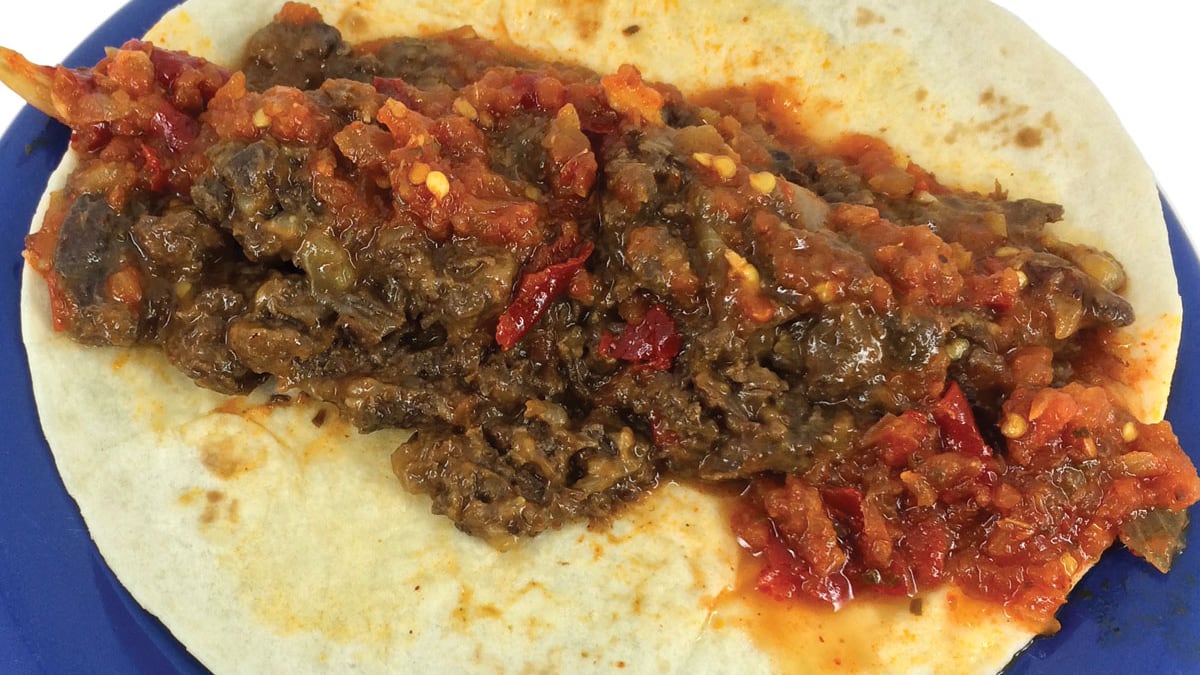Behind the butcher counter in a Mexican grocery store, they usually have brontosaurus-size slabs of beef jerky. What sort of man gnaws from one posterboard-sized piece of jerky? Where does he store it between chaws?
Well, that's not jerky. That's carne seca, and you're better off thinking of it as a specialized cut of super-dry-aged steak. In that form, it's tough as a boot and not especially tasty. But it's an ingredient in other dishes. Specifically, machaca—the king of all Mexican meats.
The Mexican cattle industry is in the hot and dry northwestern corner of the country. In the days before refrigeration, ranchers in the Sonoran Desert would cut their beef into thin slices and hang it to dry into jerky, a fast process when it's 110 degrees with no humidity. The result was carne seca ("dried meat") that would later be shredded and/or rehydrated to make machaca.
You'll find machaca on menus all over Mexico and the United States. Most of it isn't the same thing. Outside Sonora, machaca becomes shorthand for a combination of stewed beef and eggs, typically eaten for breakfast. When it is made with carne seca, it's dry and jerkylike, served like bacon bits on scrambled eggs. In Sonora, versions vary from pan-fried shavings to ultra-beefy stew made with rehydrated beef.
My favorite Sonoran machaca comes from a place called Carolina's in South Phoenix. Carolina's has bars on the windows and a lunch rush that flows like the Colorado River. The restaurant is famous for its burros—in Sonora, there's no "-ito"—made with flour tortillas and machaca. Those machaca burros are among the best things I've ever eaten—the beefiness is otherworldly, like a wagyu rib-eye magically made of spicy jerky then turned into beef bourguignon. And it comes inside a still-steaming flour tortilla.
I'm not alone in my obsession. Googling turned up three threads in which people discussed the "food epiphany" of machaca and the disappointment of available recipes, which "sound like shortcut versions that are basically shredded stewed meat, which does not even come close to the real thing."
Several other sites pointed to a recipe like the one my wife adapted, a way of cooking chuck roast in a slow cooker. Her recipe makes very nice beef, but it's not quite machaca.
How does Carolina's do it? I wish I could tell you. Sadly, the recipe for this wonderful jerky stew is a closely guarded secret. Carolina's is owned by three sisters who trace their Arizona ancestry back eight generations, to when Phoenix was still part of Mexico. "We don't even know how to make it," said a clerk who answered the phone. "I don't think they'll tell you anything."
Indeed, two calls and an email got no response.
So I decided to make my own machaca. I started with a recipe adapted from Diana Kennedy's The Art of Mexican Cooking. With help from Mi Mero Mole owner Nick Zukin, I actually reached out to Kennedy, the Julia Child of Mexico, for help. Unfortunately, her knowledge is focused to the south, below the range of the Sonoran specialty I was trying to re-create.
So I bought 2½ pounds of carne seca (that's $50—dried beef ain't cheap) from La Tapatia Market at Southeast 183rd Avenue and Stark Street, and spent the weekend experimenting with adapted recipes.
Here's the best I came up with. It can't touch Carolina's, but it's better than that stuff you find mixed with eggs around town.
Machaca
Marinade
5 cups beef broth
1/8 cup soy sauce
1/4 cup vegetable oil
1 teaspoon garlic powder
1 teaspoon onion powder
1 teaspoon chili powder
1/2 teaspoon salt
1/8 teaspoon black pepper
Beef and sauce
1 pound carne seca (dried, unseasoned beef jerky in large slabs, available at the meat counter at Mexican markets, including La Tapatia in Southeast Portland)
1/4 cup cooking oil
Half yellow onion, diced
4 cloves garlic, minced
1/4 cup beef broth
12 ounces red chile sauce
4 dried chile de árbol peppers, diced, with seeds
1 tablespoon cumin
1 tablespoon oregano
Salt to taste
Hot sauce
12 chile de árbol peppers, diced, with seeds
1 ounce sesame oil
12-ounce can peeled whole tomatoes
2 cloves garlic
Half white onion, diced
1 teaspoon oregano
Salt and pepper to taste
Combine ingredients for the marinade in a large plastic container and shake to mix.
Add dried beef and marinate for four to eight hours, agitating the marinade to soak the beef and moving the beef every few hours. After two or three hours, the beef should be soft enough to tear into smaller pieces. Do that and shake some more to soften the beef as much as possible.
After marinating, discard the marinade and put the softened, torn pieces of carne seca into a food processor to shred as finely as possible. (You can also do this in the traditional way, with a mortar and pestle.)
Put onions and oil in a slow cooker and saute. Add garlic and árbol peppers. After garlic, onions and chiles are lightly browned, add beef broth, red chile sauce and salt, stirring to combine. Add shredded meat from the food processor and stir. Set slow cooker to low and cook for four hours or until meat is soft but relatively dry.
To make hot sauce, chop árbol peppers and brown in sesame oil. Dice garlic, onions and put tomatoes through food processor until they're nearly liquid. Add garlic and onions to chile peppers. Simmer for one hour. Add oregano, salt and pepper to taste. Chill after cooking.
Serve machaca on flour tortillas with hot sauce on the side.
